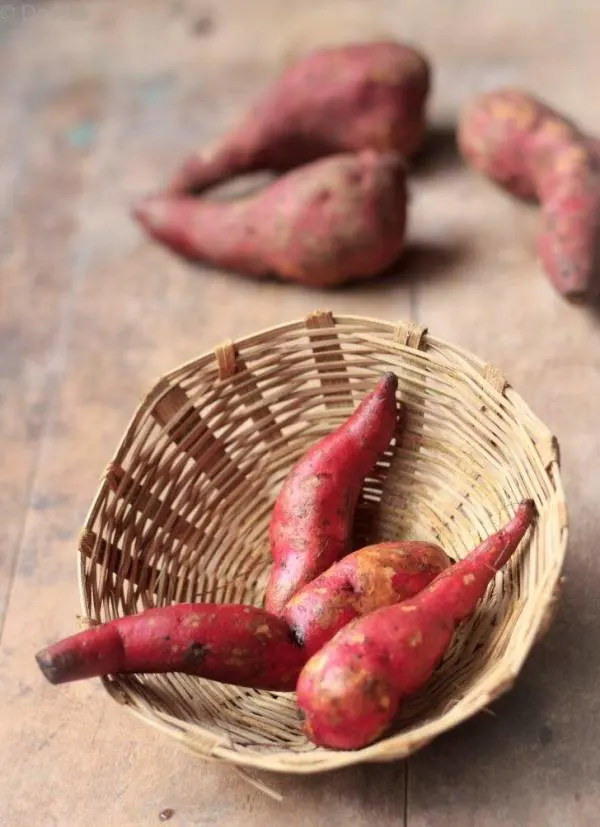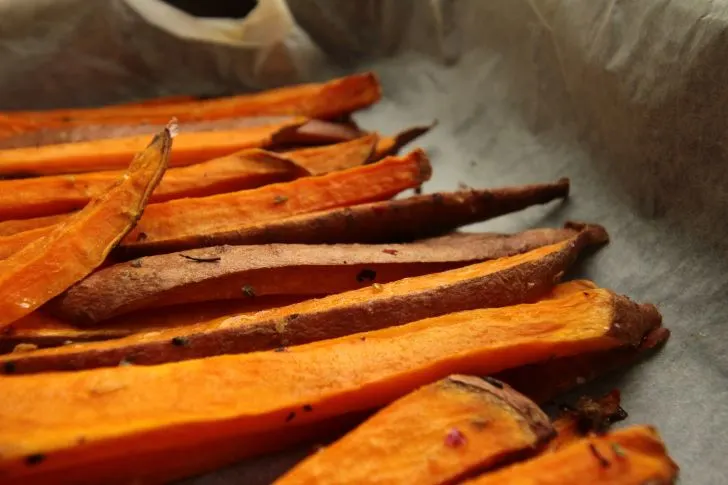Sweet potatoes are super versatile and absolutely delightful!
These little wonders aren’t just mouth-watering; they offer plenty of essential nutrients, making them a fantastic choice for a balanced diet.
Now, here’s where things get interesting.
Sweet potatoes can be a bit puzzling when categorizing them as a fruit or a vegetable.
You see, they possess a naturally sweet taste that puts them in a league. That has led to sweet potatoes being classified as both fruits and vegetables in various countries. It’s like they’ve got one foot in each world, keeping us guessing but ultimately enriching our culinary adventures.
But where did they actually belong? You want to know, right?
Let’s settle a delicious debate that has puzzled many of us: Is a sweet potato a fruit or a vegetable?
So, without wasting any further time, let’s dig in!

Is a Sweet Potato a Vegetable or a Fruit?
Fruits and vegetables have been separated for centuries for cultural and historical reasons.
And still, there are some foods people don’t find clarity about.
The case is similar for sweet potatoes.
Because of their sweet taste, many people find it hard to believe that it is a vegetable and consider it some fruit.
Let’s discuss the difference between a fruit and a vegetable and how different foods have been classified botanically.
What Is the Difference Between a Fruit and a Vegetable?
The distinction between fruits and vegetables is primarily based on botanical and culinary classifications.
While fruits and vegetables are often used interchangeably in casual conversation, they have different scientific definitions.
Botanical Definitions
From a botanical point of view, a fruit is the mature ovary of a flowering plant.
When a flower is pollinated—the ovary inside it gets fertilized, leading to the development of seeds within the fruit.
Want to know something interesting?
The primary purpose of fruits is to protect and aid in the dispersal of seeds.
Examples of botanically classified fruits include:
- Cucumber
- Melon
- Pumpkin
In contrast, vegetables are derived from various parts of plants other than the ovary.
They can include:
- Roots (carrots, radishes)
- Stems (celery, asparagus)
- Leaves (spinach, lettuce)
- Flowers (cauliflower, broccoli)
Vegetables serve different functions for plants, such as:
- Storing nutrients (in roots)
- Conducting water and nutrients (in stems)
- Capturing sunlight for photosynthesis (in leaves)
Now, let’s look at the culinary definitions.
Culinary Definitions
The culinary definition of fruits and vegetables is more subjective and varies across cultures.
In the culinary context, fruits are often characterized by their sweet or tart taste and are typically consumed raw or used in desserts, jams, and beverages.
Their natural sugars make them suitable for snacks or as ingredients in sweet dishes.
Some common culinary fruits include:
- Apples
- Oranges
- Peaches
- Grapes
Conversely, vegetables are often described as having a savory, less sweet, or bitter taste.
They are flexible and can be consumed raw or cooked in savory dishes, such as stir-fries, salads, soups, stews, and side dishes.
Examples of culinary vegetables include:
- Carrots
- Broccoli
- Lettuce
- Spinach
But there is more to it.
Overlapping Categories
There are cases where botanical fruits are often considered vegetables in culinary contexts.
It is because the culinary classification is based on cultural and culinary traditions rather than strict botanical definitions.
Some examples of such fruits that are commonly referred to as vegetables include:
- Tomatoes
- Cucumbers
- Peppers
While they are botanically classified as fruits due to their origin in the ovary, they are typically used in savory dishes and have a less sweet taste.
Therefore, it is crucial to resolve the debate regarding all these foods.
So, let’s start with the sweet potatoes.
Resolving the Sweet Potato Debate!
The sweet potato debate has confused many with contradictory opinions about its classification.
People usually get confused about fruits and vegetables because of the usage of these terms in everyday language. While fruits and vegetables have distinct botanical definitions, their culinary and cultural interpretations often overlap, leading to misconceptions.
It’s essential to recognize that food usage cannot affect how we see and classify them.
Sweet potatoes are commonly used in savory dishes, making them appear more vegetable-like.

However, this does not necessarily dictate their botanical classification.
It is because different cultures have different approaches to classifying sweet potatoes.
For instance:
In some cuisines, sweet potatoes are used in desserts.
Thus, aligning them more closely with the fruit category regarding culinary classification.
Botanically speaking, sweet potatoes are classified as vegetables due to their origin from tuberous roots, which are not the result of fertilized flowers.
That aside, let’s learn some health benefits of sweet potatoes.
Are Sweet Potatoes Healthy?
Sweet potatoes are indeed considered a healthy food option due to their numerous nutritional benefits.
Here are some key points to consider when evaluating the healthiness of sweet potatoes:
Nutrient-Rich
Sweet potatoes are packed with essential nutrients.
They are an excellent source of dietary fiber, which aids in digestion, helps maintain a healthy weight, and supports heart health.
They are also a good source of vitamins and minerals, including:
- Vitamin A
- Vitamin C
- Potassium
- Manganese
Vitamin A is especially abundant in sweet potatoes and plays a vital role in vision, immune function, and cell growth.
Antioxidant Properties
Sweet potatoes are rich in antioxidants, particularly beta-carotene, which gives them their vibrant orange color.
Beta-carotene is converted into vitamin A in the body and acts as a powerful antioxidant.
Antioxidants also have anti-inflammatory properties and may help lower the probability of chronic diseases, such as:
- Heart disease
- Certain types of cancer
- Blood sugar regulation
Despite their naturally sweet taste, sweet potatoes have a relatively low glycemic index (GI). The glycemic index measures how quickly a food raises blood sugar levels. The low GI of sweet potatoes means that they have a minimum impact on blood sugar levels compared to high-GI foods.
Additionally, the high fiber content in sweet potatoes helps slow down the digestion and absorption of carbohydrates, further aiding in blood sugar control.
Heart Health
The nutritional composition of sweet potatoes supports the heart’s health.
They are low in fat and cholesterol and contain potassium, a mineral that helps regulate blood pressure levels.
The fiber in sweet potatoes can also contribute to a healthy cardiovascular system by reducing the risk of coronary heart disease.
Digestive Health
Sweet potatoes are an excellent dietary fiber source for a healthy digestive system.
Fiber adds bulk to the stool and promotes regular bowel movements, preventing constipation.
It also nourishes beneficial gut bacteria and aids in maintaining a balanced gut microbiome, which is crucial for overall health and immune function.

FAQs
Here are the answers to some frequently asked questions.
Why Is There Confusion About Whether Sweet Potatoes Are Fruits or Vegetables?
The confusion arises because sweet potatoes are sometimes called “yams.”
While true yams are a different type of tuberous root vegetable, in the United States, the term “yam” is often used interchangeably with sweet potatoes, causing some confusion about their classification.
Are Sweet Potatoes Classified as Fruits Because They Have Seeds?
Although sweet potatoes produce seeds, they are primarily propagated vegetatively using plant cuttings.
Therefore, the presence of seeds does not determine their classification as a fruit.
Are Sweet Potatoes Suitable for People with Dietary Restrictions?
Sweet potatoes are naturally gluten-free and can be enjoyed by individuals with gluten sensitivities or celiac disease.
However, if you have specific dietary concerns or allergies, consulting with a healthcare professional or registered dietitian is always recommended.
That’s all for today!
Now it’s time to move toward the conclusion and summarize the talk here.
Conclusion!
I hope this post has cleared your head about classifying sweet potatoes as a fruit or a vegetable.
Sweet potatoes are vegetables both in botanical and culinary terms.
Still, some cultures use sweet potatoes as desserts; they may classify them as fruit.
But remember, culinary usage doesn’t decide the classification of food.
So, we need to go with the more accurate botanical classification, according to which sweet potato is considered a vegetable.
So, from now on, don’t let the fruit and vegetable confusion stop you from enjoying the goodness of sweet potatoes—add them to your meal and enjoy their unique flavor and health benefits.
Regards,
Moiz Atiq.
